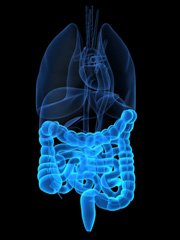Advertisment
UEGW 2015: Complications of Crohn’s disease

by Maria Dalby: Accurate diagnosis and monitoring are key elements in the prevention of long-term complications of Crohn’s disease including stenosis, strictures and perforation. Rising Star award winner Dr Ingrid Ordas from Barcelona opened a symposium on this topic with a discussion of the role of magnetic resonance (MR) enterography for non-invasive morphological assessment of disease activity and severity in CD. Although the gold standard for diagnostic and therapeutic surveillance in IBD, colonoscopy is a highly invasive procedure which frequently requires sedation or an anaesthetic; in addition, it is incomplete in terms of the location that can be accessed and the findings are limited to the mucosa, rendering it unsuitable for monitoring for transmural disease. Given the progressive nature of CD, it is vital to be able to establish the correct phenotype at diagnosis and monitor disease progression and therapeutic response. Researchers and clinicians at Dr Ordas’ centre in Barcelona have developed the Magnetic Resonance Index of Activity (MaRIA) which provides an independent predictive value for endoscopic activity and severity based on mural thickening and oedema, contrast enhancement and ulcers. MaRIA has also been shown to correlate with the Crohn’s disease endoscopic index of severity (CDEIS).1 The inter- and intra-observer agreement rates for the MaRIA score was evaluated through central readings of 50 MRs by four radiologists in Europe and North America and were found to be very high (intraclass correlation coefficient [ICC] 0.71 and 0.89, respectively).2 A prospective multicentre study in 48 patients with active CD and ulcers in at least one ileocolonic segment showed that ulcer healing could be determined by MR with 90% accuracy and endoscopic remission with 83% accuracy compared with ileocolonoscopy, and the MaRIA score accurately detected healing and changes in lesion severity.3
MR enterography can be used for calculating the Lémann Index for quantifying cumulative structural bowel damage in CD patients. The Lémann Index is obtained by dividing the gastrointestinal tract (GIT) into four segments – upper GIT, small bowel, colon, anus – and scoring the severity of strictures, penetrating lesions, and surgical resections on a scale from 0 (normal tissue) to 3 (severe) for each segment.4 The Lémann Index has been shown to be sufficiently sensitive to change to detect reversal of intestinal damage with anti-TNF treatment in clinical trials.5, 6 Dr Ordas concluded that MR enterography has an important role to play, not only in the diagnostic work-up of CD but also to monitor the therapeutic response to therapy and as guidance for any surgical approach.
Stricturing CD poses a considerable challenge for both gastroenterologists and surgeons. In a tandem talk on managing this challenge, Dr Alessandro Armuzzi from Rome and Dr Antonino Spinelli from Milan agreed that in an ideal world, patients at risk of developing complications such as strictures should be identified and effective treatment commenced at the inflammatory stage, well before any complications have had a chance to develop. The results of the REACT 1 cluster randomised controlled trial indicate that although the rate of symptomatic remission was similar amongst CD patients who received an early combined immunosuppression regimen consisting of an anti-TNF and an antimetabolite compared with those who received a conventional regimen, the former had significantly longer freedom from hospitalisation, surgery or complication.7 Similarly, the POCER study showed that a regimen of active care with early colonoscopy and treatment step-up for recurrence is superior to conventional therapy for prevention of CD recurrence post-surgery.8
However, in the real world, most patients have complications already at the time of diagnosis. The classical risk factors for developing strictures and obstruction include steroid treatment, ileal disease, and severe disease.9 MR enterography is the preferred technique for identifying and characterising strictures. Endoscopic balloon dilatation (EBD) is a recognised treatment for symptomatic CD strictures; however, a recent systematic review and meta-analysis showed that although the technical and symptomatic response rates were high, so were the complication rates and the need for surgery in studies with up to 5 years’ follow-up.10 Dr Armuzzi and Dr Spinelli concluded by stressing the importance of close collaboration between gastroenterologists and surgeons in the management of stricturing CD, as there are no clear answers and no single approach that fits all patients.
References
- Rimola J, Ordas I, Rodriguez S, et al. Magnetic resonance imaging for evaluation of Crohn’s disease: validation of parameters of severity and quantitative index of activity. Inflamm Bowel Dis 2011;17:1759-68.
- Ordás I, Rimola J, Zou G, et al. Tu1213 Reproducibility of Magnetic Resonance Enterography Assessment of Disease Activity in Crohn’s Disease Using Central Readers. Gastroenterology;148:S-824.
- Ordas I, Rimola J, Rodriguez S, et al. Accuracy of magnetic resonance enterography in assessing response to therapy and mucosal healing in patients with Crohn’s disease. Gastroenterology 2014;146:374-82 e1.
- Pariente B, Mary J-Y, Danese S, et al. Development of the Lémann Index to Assess Digestive Tract Damage in Patients With Crohn’s Disease. Gastroenterology;148:52-63.e3.
- Fiorino G, Bonifacio C, Allocca M, et al. Bowel Damage as Assessed by the Lémann Index is Reversible on Anti-TNF Therapy for Crohn’s Disease. Journal of Crohn’s and Colitis 2015;9:633-639.
- Gilletta C, Lewin M, Bourrier A, et al. Changes in the Lemann Index Values During the First Years of Crohn’s Disease. Clin Gastroenterol Hepatol 2015;13:1633-40.e3.
- Khanna R, Bressler B, Levesque BG, et al. Early combined immunosuppression for the management of Crohn’s disease (REACT): a cluster randomised controlled trial. Lancet 2015.
- De Cruz P, Kamm MA, Hamilton AL, et al. Crohn’s disease management after intestinal resection: a randomised trial. Lancet 2015;385:1406-17.
- Lichtenstein GR, Olson A, Travers S, et al. Factors Associated with the Development of Intestinal Strictures or Obstructions in Patients with Crohn’s Disease. Am J Gastroenterol 2006;101:1030-1038.
- Morar PS, Faiz O, Warusavitarne J, et al. Systematic review with meta-analysis: endoscopic balloon dilatation for Crohn’s disease strictures. Aliment Pharmacol Ther 2015;42:1137-48.





